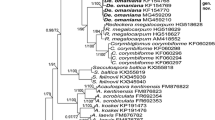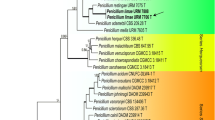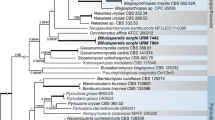Abstract
During studies on Mucorales in semiarid and littoral dune areas in the northeast of Brazil, two cultures of an Absidia-like species were isolated from soil. They were characterized based on morphological, physiological and molecular data (5.8S and LSU rDNA sequences). The phylogenetic analyses of the isolates revealed that they belong to the Lichtheimiaceae and are closely related to species of Lichtheimia. The two isolates produced simple or branched, erect and circinate sporophores, occasionally with a septum under the sporangia, characteristics also common in Lichtheimia species. However, different from the described Lichtheimia species, the columellae of our isolates were mainly short hemispherical, never spatulate or elliptical and without projections. Sometimes, a long conical or bell shaped apophysis was found. Both isolates grew better at 30–35 °C, with no development at 42 °C, and giant cells were not observed. Based on the evidence of the analyzed datasets a new species of Lichtheimia is proposed.



Similar content being viewed by others
References
[MME] Ministério das Minas e energia (2005a) Projeto cadastro de fontes de abastecimento por água subterrânea. Pernambuco. Diagnóstico do Município de Araripina. Secretaria de Geologia, Mineração e Transformação Mineral, Brasil
[MME] Ministério das Minas e energia (2005b) Projeto cadastro de fontes de abastecimento por água subterrânea. Paraíba. Diagnóstico do Município de Mataraca. Secretaria de Geologia, Mineração e Transformação Mineral, Brasil
Alastruey-Izquierdo A, Hoffmann K, de Hoog GS, Rodriguez-Tudela JL, Voigt K, Bibashi E, Walther G (2010) Species recognition and clinical relevance of the Zygomycetous Genus Lichtheimia (syn. Absidia Pro Parte, Mycocladus). J Clin Microbiol 48:2154–2170
Álvarez E, Cano J, Stchigel AM, Sutton DA, Fothergill AW, Salas V, Rinaldi MG, Guarro J (2011) Two new species of Mucor from clinical samples. Med Mycol 49:62–72
Beauverie J (1900) Mycocladus verticillatus (gen. nov. sp. nov.). Ann Univ Lyon Sér 2 Sci Méd 3:162–180
Benny GL (2008) The methods used by Dr. R. K. Benjamin, and other mycologists, to isolate Zygomycetes. Aliso 26:37–61
Benny GL (2010) Zygomycetes. Published on the internet at www.zygomycetes.org
Coleman AW, Vacquier VD (2002) Exploring the phylogenetic utility of ITS sequences for animals: a test case for abalone (Haliotis). J Mol Evol 54:246–257. doi:10.1007/s00239-001-0006-0
de Souza JI, Pires-Zottarelli CLA, dos Santos JF, Costa JP, Harakava R (2012) Isomucor (Mucoromycotina): a new genus from a Cerrado reserve in state of São Paulo, Brazil. Mycologia 104:232–241. doi:10.3852/11-133
Ellis JJ, Hesseltine CW (1966) Species of Absidia with ovoid sporangiospores. II. Sabouraudia 5:59–77
Góes-Neto A, Loguercio-Leite C, Guerrero RT (2005) DNA extraction from frozen field-collected and dehydrated herbarium fungal basidiomata: performance of SDS and CTAB-based methods. Biotemas 18:19–32
Gruber AR, Lorenz R, Bernhart SH, Neubock R, Hofacker IL (2008) The Vienna RNA websuite. Nucl Acids Res 36:70–74. doi:10.1093/nar/gkn188
Guindon S, Gascuel O (2003) A simple, fast, and accurate algorithm to estimate large phylogenies by maximum likelihood. Syst Biol 52:696–704. doi:10.1080/10635150390235520
Hall TA (1999) BioEdit: a user-friendly biological sequence alignment editor and analysis program for Windows 95/98/NT. Nucleic Acids Symp Ser 41:95–98
Hesseltine CW, Ellis JJ (1964) The genus Absidia: Gongronella and cylindrical-spored species of Absidia. Mycologia 56:568–601. doi:10.2307/3756362
Hesseltine CW, Ellis JJ (1966) Species of Absidia with ovoid sporangiospores. I. Mycologia 58:761–785. doi:10.2307/3756851
Hoffmann K, Voigt K (2009) Absidia parricida plays a dominant role in biotrophic fusion parasitism among mucoralean fungi (Zygomycetes): Lentamyces, a new genus for A. parricida and A. zychae. Plant Biol 10:537–554
Hoffmann K, Discher S, Voigt K (2007) Revision of the genus Absidia (Mucorales, Zygomycetes) based on physiological, phylogenetic, and morphological characters; thermotolerant Absidia spp. form a coherent group, the Mycocladiaceae fam. nov. Mycol Res 111:1169–1183. doi:10.1016/j.mycres.2007.07.002
Hoffmann K, Walther G, Voigt K (2009) Mycocladus vs. Lichtheimia: a correction (Lichtheimiaceae fam. nov., Mucorales, Mucoromycotina). Mycol Res 113:277–278
Iwen PC, Hinrichs SH, Rupp ME (2002) Utilization of the internal transcribed spacer regions as molecular targets to detect and identify human fungal pathogens. Med Mycol 40:87–109. doi:10.1080/mmy.40.1.87.109
Kirk PM, Cannon PF, Minter DW, Stalpers JA (2008) Ainsworth & Bisby’s dictionary of the fungi, 10th edn. CAB International, Wallingford
Koetschan C, Hackl T, Müller T, Wolf M, Förster F, Schultz J (2012) ITS2 database IV: Interactive taxon sampling for internal transcribed spacer 2 based phylogenies. Mol Phylogenet Evol 63:585–588. doi:10.1016/j.ympev.2012.01.026
Larkin MA, Blackshields G, Brown NP, Chenna R, McGettigan PA, McWilliam H, Valentin F, Wallace IM, Wilm A, Lopez R, Thompson JD, Gibson TJ, Higgins DG (2007) Clustal W and Clustal X version 2.0. Bioinformatics 23:2947–2948. doi:10.1093/bioinformatics/btm404
Maerz A, Paul MR (1950) A dictionary of color. McGraw-Hill book Company, USA
Mayden RL (1997) A hierarchy of species concepts: the denouement in the saga of the species problem. In: Claridge MF, Dawah HA, Wilson MR (eds) Species: the units of biodiversity. Chapman & Hall, London, pp 381–424
Milne I, Wright F, Rowe G, Marshal DF, Husmeier D, McGuire G (2004) TOPALi: software for automatic identification of recombinant sequences within DNA multiple alignments. Bioinformatics 20:1806–1807. doi:10.1093/bioinformatics/bth155
Mirza JH, Khan SM, Begum S, Shagufta S (1979) Mucorales of Pakistan. University of Agriculture, Faisalabad
Misra PC, Srivastava KJ, Lata K (1979) Apophysomyces, a new genus of the Mucorales. Mycotaxon 8:377–382
Müller T, Philippi N, Dandekar T, Schultz J, Wolf M (2007) Distinguishing species. RNA 13:1469–1472. doi:10.1261/rna.617107
Ronquist F, Huelsenbeck JP (2003) MrBayes 3: Bayesian phylogenetic inference under mixed models. Bioinformatics 19:1572–1574. doi:10.1093/bioinformatics/btg180
Santos MJS, de Oliveira PC, Trufem SFB (2003) Morphological observations on Absidia corymbifera and Absidia blakesleeana strains preserved under mineral oil. Mycoses 46:402–406. doi:10.1046/j.0933-7407.2003.00923.x
Schipper MAA (1990) Notes on Mucorales—I. Observations on Absidia. Persoonia 14:133–149
Schultz J, Müller T, Achtziger M, Seibel PN, Dandekar T, Wolf M (2006) The internal transcribed spacer 2 database–a web server for (not only) low level phylogenetic analyses. Nucleic Acids Res 34:704–707. doi:10.1093/nar/gkl129
Schwarz P, Bretagne S, Gantier JC, Garcia-Hermoso D, Lortholary O, Dromer F, Dannaoui E (2006) Molecular identification of Zygomycetes from culture and experimentally infected tissues. J Clin Microbiol 44:340–349. doi:10.1128/JCM.44.2.340-349.2006
Seibel PN, Müller T, Dandekar T, Schultz J, Wolf M (2006) 4SALE—a tool for synchronous RNA sequence and secondary structure alignment and editing. BMC Bioinformatics 7:498
Seibel PN, Müller T, Dandekar T, Wolf M (2008) Synchronous visual analysis and editing of RNA sequence and secondary structure alignments using 4SALE. BMC Res Notes 1:91. doi:10.1186/1756-0500-1-91
Swofford DL (2003) PAUP*. Phylogenetic analysis using parsimony (*and Other Methods). Sinauer Associates, Sunderland
Taylor JW, Jacobson DJ, Kroken S, Kasuga T, Geiser DM, Hibbett DS, Fisher MC (2000) Phylogenetic species recognition and species concepts in fungi. Fungal Genet Biol 31:21–32. doi:10.1006/fgbi.2000.1228
van Tieghem P (1876) Troisième mémoire sur les Mucorinées. Ann Sci Nat Bot sér VI 4:312–399
van Tuinen D, Zhao B, Gianinazzi-Pearson V (1998) PCR in studies of AM fungi: from primers to application. In: Varma AK (ed) Mycorrhizal manual. Springer, Berlin, pp 387–399. doi:10.1007/978-3-642-60268-9_24
Vuillemin P (1903) Le genre Tieghemella et la série de Absidées. Bull Soc Mycol France 19:119–127
White TJ, Bruns T, Lee S, Taylor J (1990) Amplification and direct sequencing of fungal ribosomal RNA genes for phylogenetics. In: Innis MA, Gelfand DH, Sninsky JJ, White TJ (eds) PCR protocols: a guide to methods and applications. Academic, San Diego, pp 315–322
Zheng R-Y, Chen G-Q, Huang H, Liu X-Y (2007) A monograph of Rhizopus. Sydowia 59:273–372
Acknowledgments
The authors express their gratitude to Conselho Nacional de Desenvolvimento Científico e Tecnológico (CNPq) and to Coordenação de Aperfeiçoamento de Pessoal de Nível Superior (CAPES) for Master scholarships provided to Rafael José Vilela de Oliveira and Diogo Xavier de Lima, respectively. We are also thankful to Fundação de Amparo à Ciência e Tecnologia do Estado de Pernambuco (FACEPE) and to CNPq for a Post Doctoral fellowship and research grants (Protax Proc. 562330/2010-0, INCT-Herbario Virtual Proc. 573883/2008-4, Sisbiota Proc. 563342/2010-2) to the first author and to Leonor C. Maia, respectively.
Author information
Authors and Affiliations
Corresponding author
Rights and permissions
About this article
Cite this article
de A. Santiago, A.L.C.M., Hoffmann, K., Lima, D.X. et al. A new species of Lichtheimia (Mucoromycotina, Mucorales) isolated from Brazilian soil. Mycol Progress 13, 343–352 (2014). https://doi.org/10.1007/s11557-013-0920-8
Received:
Revised:
Accepted:
Published:
Issue Date:
DOI: https://doi.org/10.1007/s11557-013-0920-8




